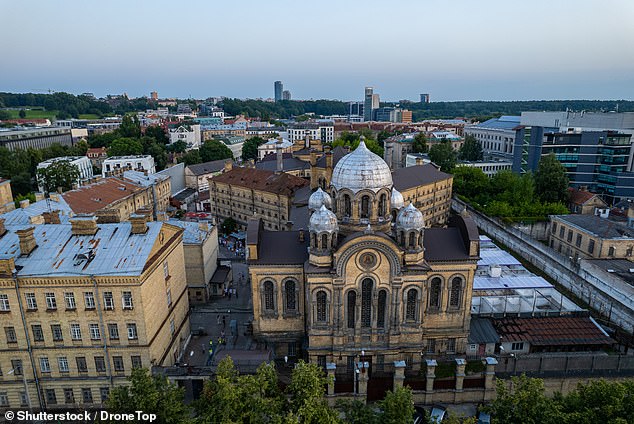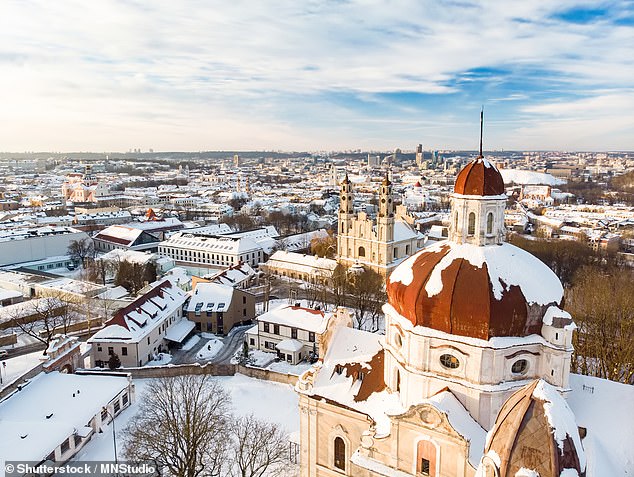Thank goodness for a -5c winter day. The frost and snow not only emphasize the ethereal beauty of Vilnius’s winding streets, the pale painted buildings of the 18th and 19th centuries and the skyline of exquisite domes and spiers, but also give a glimpse of its dark history.
Just a few decades ago, someone living here who had done nothing more than mutter a complaint against the authorities could wake up to an ominous knock on the door at 3 in the morning.
They were put in a car with blacked-out windows, taken out and locked in one of the small, icy cells that visitors can now see at the Occupation Museum, the former headquarters of the Soviet Union’s KGB.
Then they could have been tortured, sent to a labor camp in Siberia, or simply disappeared forever.
Like the other two Baltic states, Latvia and Estonia, Lithuania spent almost 45 years, from the end of World War II to the collapse of communism in 1990, under the brutal control of the Soviet Union.
Frost and snow enhance the ethereal beauty of Vilnius’s winding streets, says Adriaane Pielou
It’s a bleak recent history that helps explain the unabashed patriotism and acceptance of war heroes one constantly encounters.
Shaking the snow off my boots and cautiously descending the stairs to Dom Bow Ties, a small shop beneath one of the old town streets, I find myself in a fairy-lit world unexpectedly dominated by a photo of Winston Churchill.
Old wooden shelves line the bare brick walls of the old basement.
There are hundreds of different bow ties, priced from £18: plain, printed, linen, silk and brocade. Churchill looks down from a corner.
“My grandfather lived through World War II and loved Churchill,” says owner Paulius.
At the magnificent National Theater of Opera and Ballet, where a last-minute ticket costs me only 25 euros, I talk to a young music student.

Adriaane shakes the snow off her boots and walks through the streets of the old town, in the photo.
“Russia is a neighbor and we know what that neighbor is capable of,” he says. ‘My father was one of the Defenders who stood in front of our parliament in 1991 when the Russian tanks came out.
My father says that if they come back, everyone in Vilnius will do what we have to do. Go to our Occupation Museum and you will understand.’
Opening the heavy front door (now visibly bearing a Ukrainian flag) using the brass handle that many must have touched, I pay the entrance fee (around £5) and enter a world of meticulously documented horror.
The Jewish population of Vilna suffered the most. By the end of World War II, more than 95 percent had been killed.
Conducted by flashlight at night, there are also harrowing prison tours for €20 at the former Lukiskes prison, built in 1904, and now partly an arts center with an igloo-shaped open-air sauna.

Harrowing prison tours are offered for 20 euros at the former Lukiskes prison (pictured), built in 1904, and now part arts center with an igloo-shaped open-air sauna, says Adriaane.
After that, it’s a relief to dive into one of Vilnius’ countless warm and cheerful cafes.
On the corner of Stikliai Street in the old town, one whose exterior decorated with giant candy canes entices every passerby to stop and take a photo has the best pastries.
The cheapest is Suliniai, the only Soviet-era cafe left in the city, with Formica tables and the smell of cabbage and pork.
‘English!’ says the serious woman, dressed in a blue jumpsuit, behind the counter, finally handing me my 50p cup of tea after initially denying that she had any tea in stock.
Their tea is almost as good a bargain as the 80p bus ticket from Vilnius airport to the city centre.
From spring 2024, when Lithuania celebrates its 20th anniversary of joining the EU and NATO, Ryanair will operate flights to Lithuania from a further 15 cities across Europe.
That almost guarantees that tourists will arrive in droves, that prices will rise, and that hotels like the charming Relais & Châteaux Stikliai They might not continue to be the great bargain they are now.

